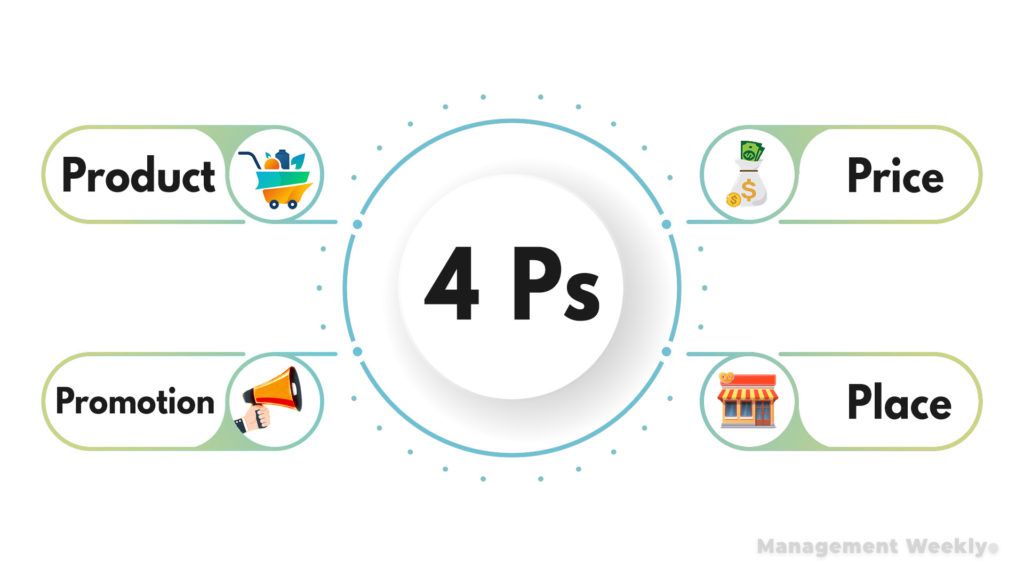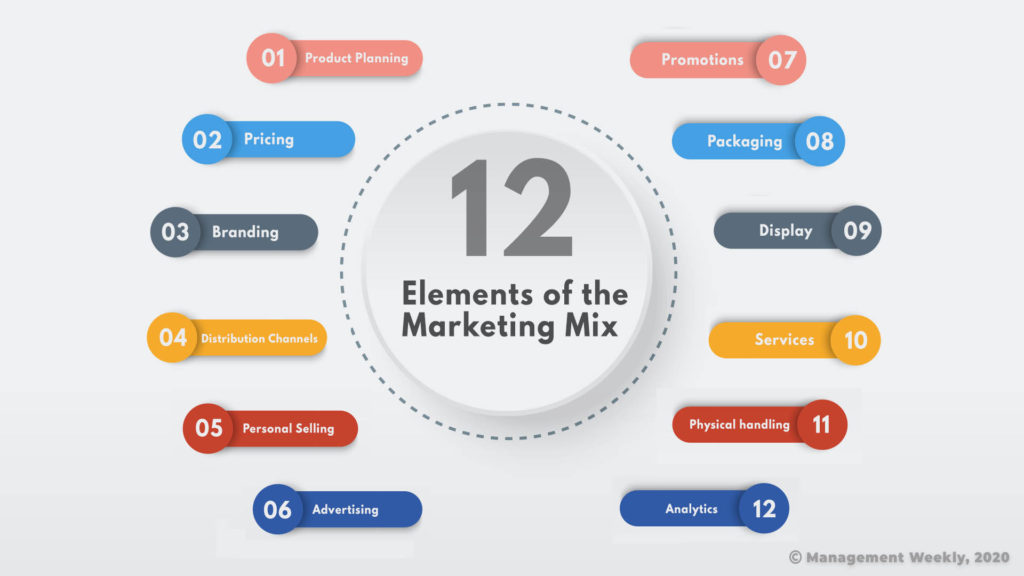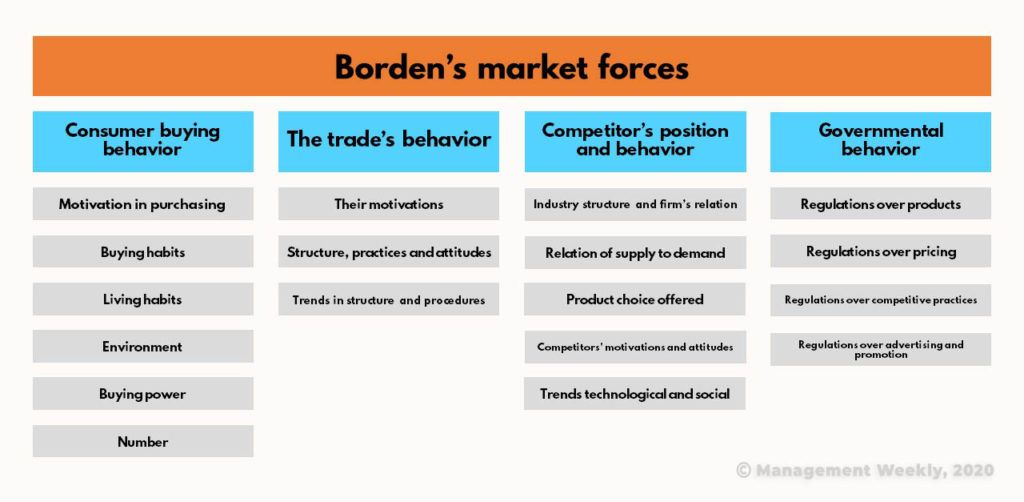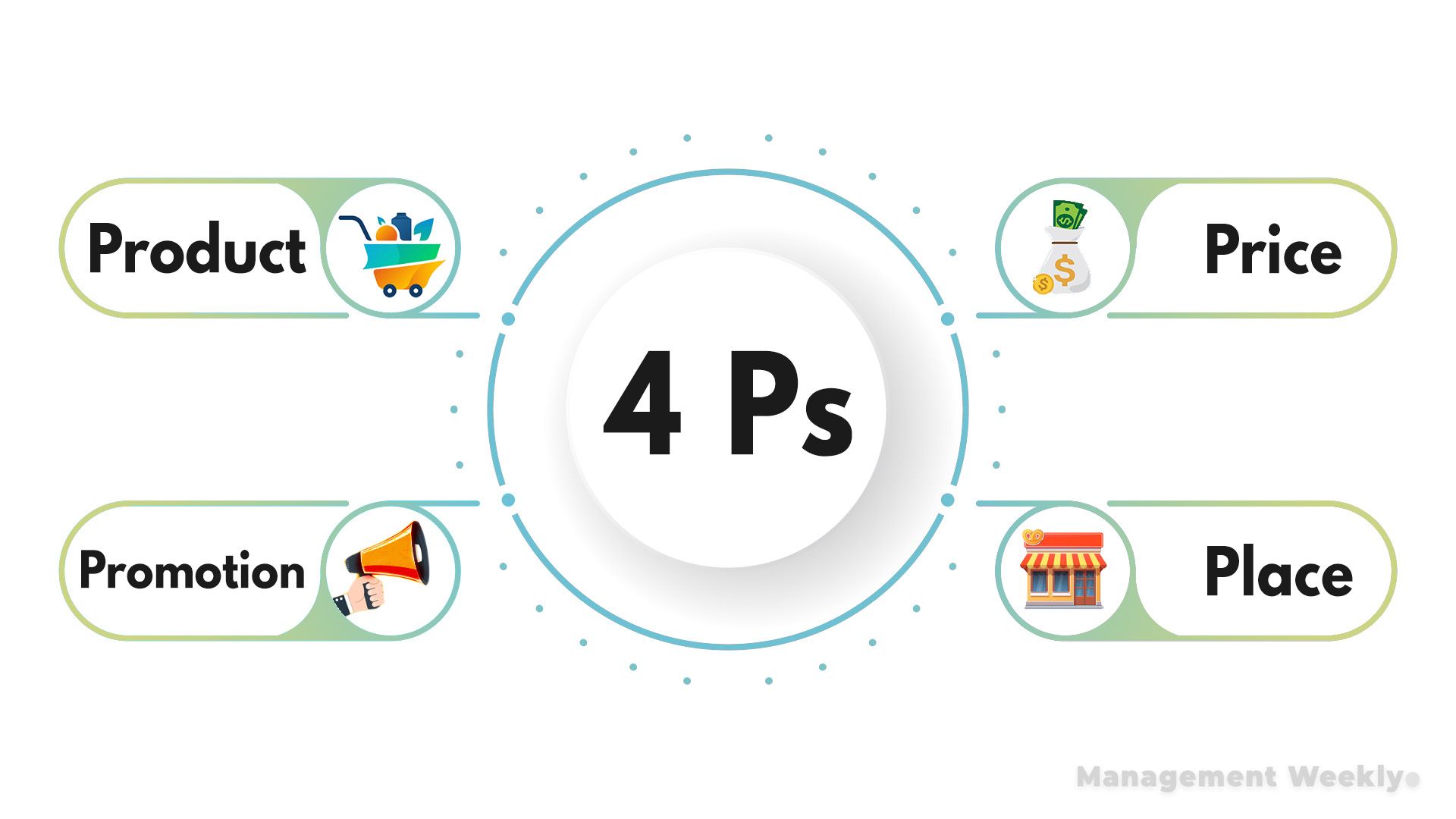The 4 Ps of the marketing mix summarizes entire marketing. Usually, your first encounter with the 4 Ps happens during the very first week of your MBA. We explain what are the 4ps of the marketing mix in simple and easy language. Follow along to get an overview of this simple yet powerful concept. Moreover, managers can read this article as a refresher or get ideas to re-mix their marketing mix!
Contents
The 4 Ps of the marketing mix
A practitioner could provide strong testimony to the fact that marketing practice is far more difficult than theory. One of the reasons why 4 Ps became popular is because it simplifies the effort. The 4 Ps are merely a set of controllable factors for a manager. The 4 Ps of the marketing mix are: product, price, place, and promotion.

The goal of marketing is to improve the profitability of the firm. Above all, marketing attempts to understand the requirements of the customer. These four Ps are elemental in developing a better understanding of the customer. Now, we will have a look at these four aspects of marketing:
Product
Products are both ‘physical products’ as well as ‘services’. Physical products such as cosmetics are tangible. On the other hand, services provide you with some utility or benefit. A beauty parlor is an example of service.
Now, as a marketer, we need to look at the products a little differently. Firstly, products need to be looked at, from the perspective of customers. Secondly, we need to understand what are the aspects of the products important to our customers. Thirdly, understand how the product will be purchased, used, and disposed of. This is the product life cycle. It helps us cater to specific needs at each stage.
Price
Pricing a product is a tricky affair. You price it too low and you lose revenue. You price it too high and you lose sales. The marketing manager’s job is to set an optimum price. Additionally, they also need to develop an appropriate discounting strategy. Finally, pricing is also important as a quality signal. McDonald’s is perceived as cheaper fast food in the United States. Meanwhile, it is perceived as a luxury item in countries like India and China.
The management of price is trickier when we factor in the subjectivity of price. We can measure the price of a product in two ways:
- Real price
- Perceived price
The real price is the price the customers have to pay. On the other hand, the perceived price is the valuation that the customer has in mind. In other words, it is a subjective price. For a customer who values the product or is in dire need, the subjective price could be higher than the real price. On the other, some customers value the product less. Alternatively, they have no immediate need for the product. Consequently, they will set a lower valuation.
Place
Another critical decision for marketers is the place. When we talk about place, we refer to the place of sale. The place strategy of the marketing mix also includes the way the product gets to the market.
Similar to the price, the place is also an important signal. Apple stores are a perfect case study of the place. Apple likes opening flamboyant, glass-shrouded stores. It is an ecosystem in itself, just like the Apple product ecosystem. There is the lure of a shiny glass building with cutting-edge models of phones, laptops, computers, and tablets. We also see brightly lit interiors, the comforting presence of store guides. It is such an interesting case study, that people from other tech companies have studied it. Now, you will find some versions of the same concept at Microsoft and Samsung stores.
Promotion
Finally, we come to the promotion. Promotion is about ‘communicating the value’ of the product to the customers. Promotion encompasses activities such as advertising, campaign management, PR activities, social media marketing.
Some critical aspects related to promotion are:
- Channels of promotion
- Segmentation
- Targeting
- Positioning
There are various channels of promotion. The channel can also serve as a quality signal. For instance, advertisements for luxury watches are more commonly found in expensive magazines or airport billboards. It also serves the purpose of reaching the right set of potential buyers. This brings us to the next point.
Segmentation, Targeting, and Positioning is a very important aspect of marketing. Segmentation means dividing your market into smaller homogenous groups. Homogeneous groups are those that behave in a similar manner. For instance, the market for watch buyers can be divided into two segments: luxury watches and utility watches. Once the segmentation is done, the right group can be targeted. Finally, positioning refers to pitching your product properly. This is an outcome of appropriate segmentation and targeting.
The story of the marketing mix
Part 1: Neil Borden’s idea

The concept of the marketing mix was developed by Prof Neil H Borden. He got the idea to look at marketing as an art of ‘mixing’ of different elements of marketing.
Borden’s got this idea from an article written by James Culliton. In this article, Culliton wrote that business executives were ‘deciders’ or ‘artists’ constantly trying to create a mixture of different activities and processes.
The marketing managers aim to work with these ingredients of activities and processes to create a ‘marketing mix’ that works! The managers look at what has worked earlier and try to create a unique approach to help the firm generate more profit.

Thereafter, Prof Borden started analyzing marketing processes, activities, and policies. He wanted to get an idea of two things:
- What are the key elements or ingredients that a manager controls?
- What behavioral forces of a customer dictates the marketing approach?
1. Key elements or ‘ingredients’ of the mix

He came up with a list of about 12 different elements of the marketing mix. These twelve areas cover different types of marketing activities. It was a breakthrough at the time.
Even today, Marketing can be visualized as a set of these activities(more or less). It is quite interesting to note that he was able to enlist ‘Fact-finding and Analysis’ as one of the elements. We have listed it as Analytics for brevity in the chart above.
2. The behavioral ‘forces’ of the mix

The chart above shows Borden’s market forces. In this model, we can see some broad areas:
- Consumer Buying Behavior
- The trade’s Behavior
- Competitor’s position and behavior
- Governmental behavior.
Each of these forces has an impact on marketing. These stakeholders try to improve their own benefits. It is the job of the marketer to cater to their requirements while fulfilling the goals of the firm.
Part 2: McCarthy’s simplification into 4Ps
You can see that there is one small problem with Borden’s mix. There are far too many ingredients to remember!
E. Jerome McCarthy simplified Borden’s framework. He clubbed together with the concepts. As a result, his model became an instant hit. It was easier for academics to teach. It was also easier for practitioners to learn and implement it.
Finally, we get the famous 4 Ps of the marketing mix:
- Product
- Price
- Place
- Promotion
The basis of his 4P framework: Mccarthy focused on the controllable factors within the market forces in Borden’s framework. This helped him narrow down on these four controllable factors.
Why is the marketing mix important?
The market is always changing. Subsequently, this dynamic nature of markets demands certain things from the managers. Managers need to come up with appropriate ways of dealing with the specific set of market conditions.
The 4Ps of marketing helps in developing solutions to these problems. It also helps in staying competitive by positioning the product correctly. Above all, the 4 Ps of the marketing mix ensures that the right product at the right time is available to the right customer at the right place and at the right price!
How to use 4 Ps of the marketing mix?
We need to be very practical while working with the marketing mix. An overview of the 4 Ps is enough to get started. However, one requires a positive approach and a thorough understanding of the customer.
- Understanding the customer
The best marketing campaigns emerge from understanding the customers. Specifically, the pain points. You can use various methods to know your customer better. For example, some of these methods are customer surveys, Focus Group Discussions(FGDs), and social media analytics.
- Constructing a story (Product)
You need to think outside the box. It is not a product that sells. At least the products that sell like hotcakes are not mere products. They are stories. Now, how to make your product into a story? This answer would come from STEP 1. The needs of the customers along with market insights. The most important pain point of the customer can become your unique selling point. You just have to weave a story around it. And you are done, at least with the first P of the marketing mix, the Product.
- Valuing what your customer values( Price)
This step is critical for the top line of your firm. The revenues are strongly related with product pricing. However, don’t get into the trap of using the price incorrectly. Market projections help identify the minimum viable price for the product to break even. This will put an upper cap to the discounts. Also a lower cap to the prices. Customer surveys will help you identify what your customers think of an appropriate price for your product. This will put an upper cap to the price
- Where will you sell and how?(Place)
Firstly, we are living in the age of multi-channel retail. You need to have distinct strategies for online and offline streams. Secondly, you have to ensure that the customers are able to find your products with minimum efforts. Thirdly, it also means you facilitate a smooth shopping experience for them. Fourthly, you need to answer yourself, how will you ensure that point of sales has constant availability of the products.
- Seducing your customers(Promotion)
Here, we need to re-emphacise the importance of customer-centricity. You have to ensure that your customer KNOWS certain things. Firstly they should know you exist. Secondly, they should know that your product exist. Thirdly, they must know where to buy it. Fourthly, they must know how mich to pay for the products. Fifthly and most importantly, they must know how your product is best suited for their needs.
- Continuous improvement of the marketing mix
Development of initial solution does not mean that you are done. management is a dynamic process where things keep changing. You need to update all the 4 Ps of marketing mix based upon the feedback received.
Important questions on the 4ps of the marketing mix
The 4 Ps of the marketing mix are Product, Price, Place, and Promotion. A marketing manager’s job is to optimize their effort in these four areas.
Prof Neil H. Borden introduced the concept of ‘marketing mix’ in 1964. He proposed that marketing should be considered analogous to cooking. Marketing is all about mixing the right amount of activities in the product, price, place, and promotion.
The concept of ‘mix’ comes from cooking. Prof Borden who coined the term ‘marketing mix’ got the idea from an article that posited marketing as an art where the manager essentially mixes different amounts of efforts to get the desired result. Therefore it is defined as a ‘mix’ of product, price, place, and promotion.
No. Marketing mix is a framework. Theories require testable relationships between variables. For instance, if we say “the total sales of a computer is dependent on the percentage of revenue spent on the ad.” The relationship between sales and percent spent on ads can be tested statistically. If that relationship is found valid from data then it becomes a theory. On the other hand marketing mix is only a way of looking at marketing hence it is not a theory.
The marketing mix is an approach to develop a structure around marketing activities. In the absence of this framework, it would be difficult to co-ordinate a fruitful effort. For instance, Dell focussed its efforts on the ‘place’ of sale. They captured a large market share by lowering the ‘price’ of their computers simply by selling them directly to the customers.
The firm has a lot of control over several factors of how they create, communicate, and deliver value to their customers. The marketing mix is essentially a combination of decisions related to product, price, place, and promotion. The marketing managers decide what product to make, how to communicate, how to price, and where to sell it. These decisions are made according to the market data, experience, insights, and discussion. The marketing mix is called controllable because the manager is in control of the four Ps.
This is a tricky question. Similar to a lot of aspects of management, the answer depends on a lot of factors. The very name ‘marketing mix’ suggests that it is a mixture of ingredients. We cannot expect success by putting efforts only in one of the Ps. However, some people consider the product to be the most important as the other three Ps depend heavily on it.
The 4 Ps of the marketing mix can be altered by working on any combination of the 4 Ps. There are many ways to improve the marketing mix. Firstly, we can use market data to understand our customers better. This can help us in improving the marketing mix. Secondly, we can conduct surveys, focus group discussions, etc to improve the marketing mix. Thirdly, we can improve the marketing mix from inputs from marketers. For example, the senior managers preparing the marketing plan for a luxury product may get an idea about product placement from salespersons.
Yes of course! Anderson and Taylor published a study in 1995. It was three decades after the 4 Ps of the marketing mix was published. They commented that it had stood the test of time.
The 4 Ps of the marketing mix is even more relevant today. We have too much to choose from this age of ‘marketing noise.’ The 4 Ps can help a firm cut the clutter and provide a valuable product or service in the right form, at the right place, and at the right time.
Customer centricity is an important concept. Marketing is about creation, communication, and delivery of value to the customer. The firm merely facilitates the process. Therefore, we define our marketing mix by always thinking about the customers.
> Manufacturer’s brand name as well as the product’s brand name
> Match between product attributes and requirements
> Price
> Quality
> After sales support
Products are priced based on a number of factors like production cost, value provided to the customers, competition and type of product.
Firstly, the 4 Ps framework was developed around the 1960s when market was predominantly manufacturing-based. It is not sufficient to discuss services as well as many modern products like digital goods. Secondly, it focuses only on the activities. There is less attention given to the internal aspects of the organization as well as non-rational factors that impact marketing.

13 thoughts on “4 Ps of the marketing mix: a beginner’s guide!”